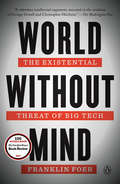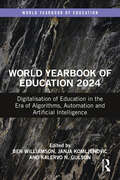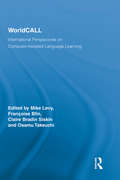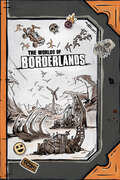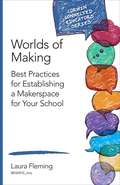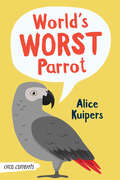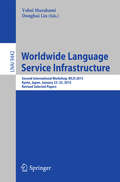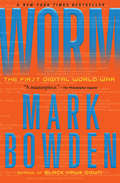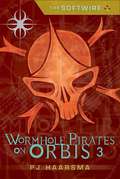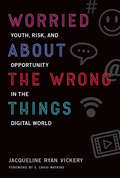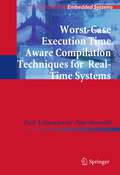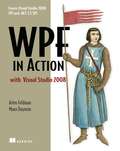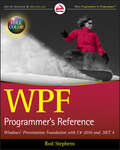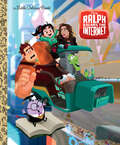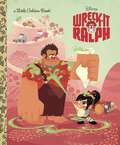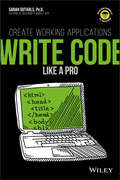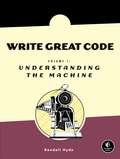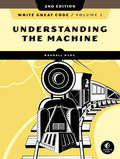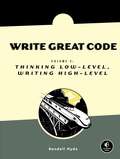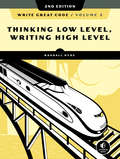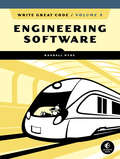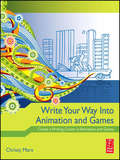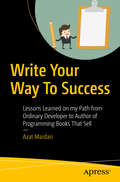- Table View
- List View
World Without Mind: The Existential Threat of Big Tech
by Franklin FoerFranklin Foer reveals the existential threat posed by big tech, and in his brilliant polemic gives us the toolkit to fight their pervasive influence. Over the past few decades there has been a revolution in terms of who controls knowledge and information. This rapid change has imperiled the way we think. Without pausing to consider the cost, the world has rushed to embrace the products and services of four titanic corporations. We shop with Amazon; socialize on Facebook; turn to Apple for entertainment; and rely on Google for information. These firms sell their efficiency and purport to make the world a better place, but what they have done instead is to enable an intoxicating level of daily convenience. As these companies have expanded, marketing themselves as champions of individuality and pluralism, their algorithms have pressed us into conformity and laid waste to privacy. They have produced an unstable and narrow culture of misinformation, and put us on a path to a world without private contemplation, autonomous thought, or solitary introspection—a world without mind. In order to restore our inner lives, we must avoid being coopted by these gigantic companies, and understand the ideas that underpin their success. Elegantly tracing the intellectual history of computer science—from Descartes and the enlightenment to Alan Turing to Stuart Brand and the hippie origins of today's Silicon Valley—Foer exposes the dark underpinnings of our most idealistic dreams for technology. The corporate ambitions of Google, Facebook, Apple, and Amazon, he argues, are trampling longstanding liberal values, especially intellectual property and privacy. This is a nascent stage in the total automation and homogenization of social, political, and intellectual life. By reclaiming our private authority over how we intellectually engage with the world, we have the power to stem the tide. At stake is nothing less than who we are, and what we will become. There have been monopolists in the past but today's corporate giants have far more nefarious aims. They’re monopolists who want access to every facet of our identities and influence over every corner of our decision-making. Until now few have grasped the sheer scale of the threat. Foer explains not just the looming existential crisis but the imperative of resistance.
World Yearbook of Education 2024: Digitalisation of Education in the Era of Algorithms, Automation and Artificial Intelligence (World Yearbook of Education)
by Ben Williamson Janja Komljenovic Kalervo N. GulsonProviding a comprehensive, global overview of the digitalisation of education, the World Yearbook of Education 2024 examines the ways advanced digital technologies are transforming educational practices, institutions and policy processes.Establishing a critical research agenda for analysing the digitalisation of education, the carefully selected chapters in this collection interrogate the current impacts of new digital technologies, emerging controversies over emerging data practices and future implications of algorithmic systems, automated decision-making and AI in education. Organised into four sections, the contributions in the collection examine the following: The historical, scientific and technical foundations of contemporary digitalisation in education The political and economic dynamics that underpin the education technology industry and new platform models of education How algorithms, automation and AI support new modes of data-driven governance and control of education systems Controversies over the inequitable effects of digitalisation in education, and proposals for data justice, ethics and regulation This resource is ideal reading for researchers, students, educational practitioners and policy officials interested in understanding the future of digital technologies in education.
WorldCALL: International Perspectives on Computer-Assisted Language Learning (Routledge Studies in Computer Assisted Language Learning)
by Mike Levy Françoisee Blin Claire Bradin Siskin Osamu TakeuchiAs technological innovation continues to affect language pedagogy, there is an increasing demand for information, exemplars, analysis and guidance. This edited volume focuses on international perspectives in Computer-Assisted Language Learning (CALL) in all of its forms, including Technology Enhanced Language Learning, Network-Based Language Learning, Information and Communication Technologies for Language Learning.
The Worlds of Borderlands
by Rick BarbaExplore a universe run amok with savage beasts, bloodthirsty bandits, and the biggest bad of all—corporations, in this full-color hardcover encyclopedia of Gearbox&’s beloved videogame franchise!The universe of Borderlands is an inhospitable wilderness that spans every biome conceivable. It&’s also a land full of opportunity, but only if you have wits, skill, and guns. Lots of guns. Many come to Pandora in search of the Vault in the hopes of finding wealth, fame, or power. This is the definitive guide to the bold people who live there and in the surrounding galaxy, the mercenaries, monsters, and wilds they contend with, and the ridiculous arsenal they employ.Dark Horse Books and Gearbox present The Worlds of Borderlands—a bombastic guide to Pandora, its surrounding planets and the characters who live there. This volume is filled with art and trivia relating to the guns, vehicles, ships, companies, and adventurers of the worlds-spanning universe—and the monstrous fauna who would eat all of them.
Worlds of Making: Best Practices for Establishing a Makerspace for Your School (Corwin Connected Educators Series)
by Laura FlemingMakerspaces: Your questions answered here! Get the nuts and bolts on imagining, planning, creating, and managing a cutting-edge Makerspace for your school community. Nationally recognized expert Laura Fleming provides all the answers in this breakthrough guide. From inception through implementation, you’ll find invaluable guidance for creating a vibrant Makerspace on any budget. Practical strategies and anecdotal examples help you: Create an action plan for your own personalized Makerspace Align activities to standards Showcase student creations Use this must-have guide to painlessly build a robust, unique learning environment that puts learning back in the hands of your students!
Worlds of Making: Best Practices for Establishing a Makerspace for Your School (Corwin Connected Educators Series)
by Laura FlemingMakerspaces: Your questions answered here! Get the nuts and bolts on imagining, planning, creating, and managing a cutting-edge Makerspace for your school community. Nationally recognized expert Laura Fleming provides all the answers in this breakthrough guide. From inception through implementation, you’ll find invaluable guidance for creating a vibrant Makerspace on any budget. Practical strategies and anecdotal examples help you: Create an action plan for your own personalized Makerspace Align activities to standards Showcase student creations Use this must-have guide to painlessly build a robust, unique learning environment that puts learning back in the hands of your students!
World's Worst Parrot (Orca Currents)
by Alice KuipersAva works hard at maintaining a certain image online and at school. As far as anyone else knows, life is great. But when she inherits an African gray parrot from her great-uncle Bernie (whom she barely remembers), Ava’s carefully crafted world starts to crumble. The parrot, Mervin, is loud and messy and obnoxious. Ava’s brother thinks it’s hilarious to post videos of Ava trying to deal with the crazy bird. He even creates a profile for the two of them. Everyone wants to see more of Ava and Mervin. Suddenly, Ava is internet famous—in the worst possible way. Her friends think the parrot is gross and start acting weird. But then a new girl at school helps Ava see that this parrot might not be the worst gift in the world and that just being yourself is the best way to be.
Worldwide Language Service Infrastructure
by Yohei Murakami Donghui LinThis book constitutes the refereed post-workshop proceedings of the Second International Workshop on Worldwide Language Service Infrastructure, WLSI 2015, held in Kyoto, Japan, in January 2015. The 4 full papers included in this volume and presented together with 2 short papers and 8 invited papers, were carefully reviewed and selected from 7 submissions. The papers are categorized into four parts: introducing metadata and annotations; providing technologies for language service platforms; atomic language services across different interfaces, policies, and development of language resources and services; and collecting reports on language service application.
Worm: The First Digital World War
by Mark BowdenFrom the bestselling author of Black Hawk Down, the gripping story of the Conficker worm—the cyberattack that nearly toppled the world. The Conficker worm infected its first computer in November 2008, and within a month had infiltrated 1.5 million computers in 195 countries. Banks, telecommunications companies, and critical government networks—including British Parliament and the French and German military—became infected almost instantaneously. No one had ever seen anything like it. By January 2009, the worm lay hidden in at least eight million computers, and the botnet of linked computers it had created was big enough that an attack might crash the world. In this “masterpiece” (The Philadelphia Inquirer), Mark Bowden expertly lays out a spellbinding tale of how hackers, researchers, millionaire Internet entrepreneurs, and computer security experts found themselves drawn into a battle between those determined to exploit the Internet and those committed to protecting it.
Wormhole Pirates on Orbis (Softwire #3)
by P. J. HaarsmaWormhole pirates close in on Johnny Turnbull and his fellow knudniks in this third installment of the Softwire series. JT senses something sinister in the air. Could it be the pirate he keeps spotting, with an alien skull and crossbones on his arm?
Worried About the Wrong Things: Youth, Risk, and Opportunity in the Digital World (The John D. and Catherine T. MacArthur Foundation Series on Digital Media and Learning)
by Jacqueline Ryan VickeryWhy media panics about online dangers overlook another urgent concern: creating equitable online opportunities for marginalized youth.It's a familiar narrative in both real life and fiction, from news reports to television storylines: a young person is bullied online, or targeted by an online predator, or exposed to sexually explicit content. The consequences are bleak; the young person is shunned, suicidal, psychologically ruined. In this book, Jacqueline Ryan Vickery argues that there are other urgent concerns about young people's online experiences besides porn, predators, and peers. We need to turn our attention to inequitable opportunities for participation in a digital culture. Technical and material obstacles prevent low-income and other marginalized young people from the positive, community-building, and creative experiences that are possible online.Vickery explains that cautionary tales about online risk have shaped the way we think about technology and youth. She analyzes the discourses of risk in popular culture, journalism, and policy, and finds that harm-driven expectations, based on a privileged perception of risk, enact control over technology. Opportunity-driven expectations, on the other hand, based on evidence and lived experience, produce discourses that acknowledge the practices and agency of young people rather than seeing them as passive victims who need to be protected.Vickery first addresses how the discourses of risk regulate and control technology, then turns to the online practices of youth at a low-income, minority-majority Texas high school. She considers the participation gap and the need for schools to teach digital literacies, privacy, and different online learning ecologies. Finally, she shows that opportunity-driven expectations can guide young people's online experiences in ways that balance protection and agency.
Worst-Case Execution Time Aware Compilation Techniques for Real-Time Systems
by Paul Lokuciejewski Peter MarwedelFor real-time systems, the worst-case execution time (WCET) is the key objective to be considered. Traditionally, code for real-time systems is generated without taking this objective into account and the WCET is computed only after code generation. Worst-Case Execution Time Aware Compilation Techniques for Real-Time Systems presents the first comprehensive approach integrating WCET considerations into the code generation process. Based on the proposed reconciliation between a compiler and a timing analyzer, a wide range of novel optimization techniques is provided. Among others, the techniques cover source code and assembly level optimizations, exploit machine learning techniques and address the design of modern systems that have to meet multiple objectives. Using these optimizations, the WCET of real-time applications can be reduced by about 30% to 45% on the average. This opens opportunities for decreasing clock speeds, costs and energy consumption of embedded processors. The proposed techniques can be used for all types real-time systems, including automotive and avionics IT systems.
WPF in Action with Visual Studio 2008: Covers Visual Studio 2008 Service Pack 1 and .NET 3.5 Service Pack 1!
by Arlen Feldman Maxx DaymonNow more than ever, Windows applications have to work well and look good. Windows Presentation Foundation (WPF), Microsoft's new user interface framework, gives you the ability to create stunning graphics, rich interactions, and highly-usable Windows applications. WPF is the API beneath Windows Vista interfaces, and it's also available for older versions of Windows. Up to this point, it has only been possible to build WPF applications manually, mainly by hand-coding in XAML-WPF's declarative XML-based markup language. The soon-to-be-released Visual Studio 2008 provides the full set of developer tools you need to take advantage of this exciting technology.The combination of WPF and Visual Studio 2008 represents the start of the next generation of Windows applications. Hand-coding XAML is fine if you're an early adopter, but to put WPF into production, you need to master the tools and application styles you'll use in your day job.WPF In Action focuses on WPF development using Visual Studio 2008 and other available tools.. The book starts with thorough coverage of the basics-layouts, styles, resources, and themes. It then takes you through several real-world scenarios, exploring common challenges and application-types. You'll build several sample applications, ranging from a simple calculator to a typical line-of-business application. Along the way, you'll add graphical elements, animation, and support for printing, accessibility, and other standard functionality.Written in a witty, engaging style, WPF In Action can be read cover-to-cover or used to reference specific problems and issues. The approach is practical and always focused on how you'll use WPF in real development scenarios. You'll learn how to handle the many new issues presented by the extreme flexibility of WPF. The authors also provide numerous tips and suggestions for how to work efficiently. Purchase of the print book comes with an offer of a free PDF, ePub, and Kindle eBook from Manning. Also available is all code from the book.
WPF Programmer's Reference
by Rod StephensBuild effective user interfaces with Windows Presentation FoundationWindows Presentation Foundation (WPF) is included with the Windows operating system and provides a programming model for building applications that provide a clear separation between the UI and business logic. Written by a leading expert on Microsoft graphics programming, this richly illustrated book provides an introduction to WPF development and explains fundamental WPF concepts.Packed with helpful examples, this reference progresses through a range of topics that gradually increase in their complexity. You'll quickly start building applications while you learn how to use both Expression Blend and Visual Studio to build UIs. In addition, the book addresses the needs of programmer who write the code behind the UI and shows you how operations can be performed using both XAML and C#.Topics Covered:Overview of WPFWPF in Visual StudioExpression BlendCommon PropertiesContent ControlsLayout ControlsUser Interaction ControlsTwo-Dimensional Drawing ControlsPropertiesPens and BrushesEvents and Code-BehindResourcesStyles and Property TriggersEvent Triggers and AnimationTemplatesThemes and SkinsPrintingData BindingCommandingTransformations and EffectsDocumentsNavigation-Based ApplicationsThree-Dimensional DrawingSilverlightEven if you only have a minimal amount of experience, by the end of the book, you will be able to build dynamic and responsive user interfaces with WPF.Note: CD-ROM/DVD and other supplementary materials are not included as part of eBook file.
Wrap: Try the tortilla hack with over 80 quick and easy recipes
by Natalie ThomsonOriginating on TikTok and quickly going viral across the rest of social media, the 'wrap hack' or '4-way wrap' involves taking a tortilla wrap and using a clever quartering technique to divide the wrap into four, placing a different filling in each section and folding into a quick and delicious meal. Suitable for leftovers, breakfasts, lunches, quick snacks and sweet treats - this genius foodie hack will not only lift you out of a sandwich rut, but will also get your creative juices flowing as you try out new flavour combinations with your friends.Wrap brings together over 80 recipes for the ingenious method all in one place. Hot, cold, meat or veggie: whatever you put into your wrap, this method is the viral sensation that has to be tried.CONTENTSChapter 1: Breakfast & BrunchIncluding Smoked salmon, Tofu scramble and Sausage hashChapter 2: Quick Light BitesIncluding Shredded duck, Spicy fish goujons and Korean blue cheeseChapter 3: Hunger FixesIncluding Veggie burrito, Pulled jackfruit and Philly cheese steakChapter 4: Something SweetIncluding Banana, caramel & chocolate, Eton mess and Apple & blackberry crumble
Wreck-It Ralph 2 Little Golden Book (Little Golden Book)
by Nancy ParentA Little Golden Book version of the exciting new Disney film Ralph Breaks the Internet: Wreck-It Ralph 2--coming to theaters in November 2018!Walt Disney Animation Studios welcomes Wreck-It Ralph back to the big screen for a smashing sequel! This time, Wreck-It Ralph leaves the arcade behind, venturing into the expansive universe of the internet--which may or may not survive Ralph's not-so-light touch. This Little Golden Book is based on the upcoming feature film Ralph Breaks the Internet: Wreck-It Ralph 2, releasing in November 2018. It is perfect for boys and girls ages 2 to 5, as well as Disney Little Golden Book collectors of all ages!
Wreck-It Ralph Little Golden Book (Little Golden Book)
by RH DisneyDisney's Wreck-It Ralph is a computer-animated feature film about a misunderstood video game villain who wants nothing more than to be the good guy for a change. But when Ralph finally gets his chance, will it mean "Game Over" for every game in the arcade? Young fans ages 2-5 will love this full-color Little Golden Book version of the movie.
Write Code Like a Pro: Create Working Applications
by Sarah GuthalsCODERS ARE ROCK STARS Coders are the people who are building the future. You can stake your own claim on the future by learning pro coding techniques. Take a look inside to figure out how and why coders think a bit differently, the basics of building a working application with a professional coding language, and how to test your app to make sure it works. Get a jump on your future as a rock-star coder today! See the big picture – get a grip on how pro coders start and finish a project Know the code – get your hands on a pro coding language and put it to work Make things happen – create a working application you can share with friends
Write Great Code, Volume 1: Understanding the Machine
by Randall HydeToday's programmers are often narrowly trained because the industry moves too fast. That's where Write Great Code, Volume 1: Understanding the Machine comes in. This, the first of four volumes by author Randall Hyde, teaches important concepts of machine organization in a language-independent fashion, giving programmers what they need to know to write great code in any language, without the usual overhead of learning assembly language to master this topic. A solid foundation in software engineering, The Write Great Code series will help programmers make wiser choices with respect to programming statements and data types when writing software.
Write Great Code, Volume 1, 2nd Edition: Understanding the Machine
by Randall HydeUnderstanding the Machine, the first volume in the landmark Write Great Code series by Randall Hyde, explains the underlying mechanics of how a computer works.This, the first volume in Randall Hyde's Write Great Code series, dives into machine organization without the extra overhead of learning assembly language programming. Written for high-level language programmers, Understanding the Machine fills in the low-level details of machine organization that are often left out of computer science and engineering courses. Learn: • How the machine represents numbers, strings, and high-level data structures, so you'll know the inherent cost of using them. • How to organize your data, so the machine can access it efficiently. • How the CPU operates, so you can write code that works the way the machine does. • How I/O devices operate, so you can maximize your application's performance when accessing those devices. • How to best use the memory hierarchy to produce the fastest possible programs.NEW IN THIS EDITION, COVERAGE OF: • Programming languages like Swift and Java • Code generation on modern 64-bit CPUs • ARM processors on mobile phones and tablets • Newer peripheral devices • Larger memory systems and large-scale SSDsGreat code is efficient code. But before you can write truly efficient code, you must understand how computer systems execute programs and how abstractions in programming languages map to the machine's low-level hardware. After all, compilers don't write the best machine code; programmers do. This book gives you the foundation upon which all great software is built.
Write Great Code, Volume 2: Thinking Low-Level, Writing High-Level
by Randall HydeIt's a critical lesson that today's computer science students aren't always being taught: How to carefully choose their high-level language statements to produce efficient code. Write Great Code, Volume 2: Thinking Low-Level, Writing High-Level shows software engineers what too many college and university courses don't - how compilers translate high-level language statements and data structures into machine code. Armed with this knowledge, they will make informed choices concerning the use of those high-level structures and help the compiler produce far better machine code - all without having to give up the productivity and portability benefits of using a high-level language.
Write Great Code, Volume 2, 2nd Edition: Thinking Low-Level, Writing High-Level
by Randall HydeExplains how compilers translate high-level language source code (like code written in Python) into low-level machine code (code that the computer can understand) to help readers understand how to produce the best low-level, computer readable machine code.In the beginning, most software was written in assembly, the CPU's low-level language, in order to achieve acceptable performance on relatively slow hardware. Early programmers were sparing in their use of high-level language code, knowing that a high-level language compiler would generate crummy, low-level machine code for their software. Today, however, many programmers write in high-level languages like Python, C/C++/C#, Java, Swift. The result is often sloppy, inefficient code. But you don't need to give up the productivity and portability of high-level languages in order to produce more efficient software.In this second volume of the Write Great Code series, you'll learn: • How to analyze the output of a compiler to verify that your code does, indeed, generate good machine code • The types of machine code statements that compilers typically generate for common control structures, so you can choose the best statements when writing HLL code • Just enough 80x86 and PowerPC assembly language to read compiler output • How compilers convert various constant and variable objects into machine data, and how to use these objects to write faster and shorter programsNEW TO THIS EDITION, COVERAGE OF: • Programming languages like Swift and Java • Code generation on modern 64-bit CPUs • ARM processors on mobile phones and tablets • Stack-based architectures like the Java Virtual Machine • Modern language systems like the Microsoft Common Language RuntimeWith an understanding of how compilers work, you'll be able to write source code that they can translate into elegant machine code. That understanding starts right here, with Write Great Code, Volume 2: Thinking Low-Level, Writing High-Level.
Write Great Code, Volume 3: Engineering Software
by Randall HydeEngineering Software, the third volume in the landmark Write Great Code series by Randall Hyde, helps you create readable and maintainable code that will generate awe from fellow programmers.The field of software engineering may value team productivity over individual growth, but legendary computer scientist Randall Hyde wants to make promising programmers into masters of their craft. To that end, Engineering Software--the latest volume in Hyde's highly regarded Write Great Code series--offers his signature in-depth coverage of everything from development methodologies and strategic productivity to object-oriented design requirements and system documentation.You'll learn: • Why following the software craftsmanship model can lead you to do your best work • How to utilize traceability to enforce consistency within your documentation • The steps for creating your own UML requirements with use-case analysis • How to leverage the IEEE documentation standards to create better softwareThis advanced apprenticeship in the skills, attitudes, and ethics of quality software development reveals the right way to apply engineering principles to programming. Hyde will teach you the rules, and show you when to break them. Along the way, he offers illuminating insights into best practices while empowering you to invent new ones.Brimming with resources and packed with examples, Engineering Software is your go-to guide for writing code that will set you apart from your peers.
Write Your Way into Animation and Games: Create a Writing Career in Animation and Games
by Christy MarxLaunch your career in writing for video games or animation with the best tips, tricks, and tutorials from the Focal press catalog--all at your fingertips. Let our award-winning writers and game developers show you how to generate ideas and create compelling storylines, concepts, and narratives for your next project. Write Your Way Into Animation and Games provides invaluable information on getting into the game and animation industries. You will benefit from decades of insider experience about the fields of animation and games, with an emphasis on what you really need to know to start working as a writer. Navigate the business aspects, gain unique skills, and develop the craft of writing specifically for aniamtion and games. Learn from the cream of the crop who have shared their knowledge and experience in these key Focal Press guides: Digital Storytelling, Second Edition by Carolyn Handler Miller Animation Writing and Development by Jean Ann Wright Writing for Animation, Comics, and Games by Christy Marx Story and Simulations for Serious Games by Nick Iuppa and Terry Borst Writing for Multimedia and the Web, Third Edition by Timothy Garrand
Write Your Way To Success: Lessons Learned On My Path From Ordinary Developer To Writer Of Multiple Programming Books That Sell
by Azat MardanLearn how to make an impact in the web world. This short book shows you that the best way to become an expert and a thought leader is to thoroughly research a topic and then publish a book on it. The great thing about writing a book is that you don’t have to risk anything - all you need is a few hours of writing per week and in no time you can have your own book that you can sell, give away at conferences, and prominently feature on your resume. Since author Azat Mardan published his first book, several high profile tech companies have tried to recruit him and his experience is not an exception! Write Your Way To Success covers everything that he has learned through publishing – see how you can do the same!What You'll LearnCreate passive incomeReview the process of a ProgWriterExamine practical tips about publishing and marketingWho This Book Is ForAny experts (or wannabe experts) in technical topics, tools, frameworks for web development, applied computer science, dev ops and QA.
